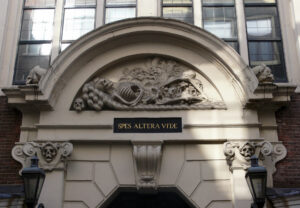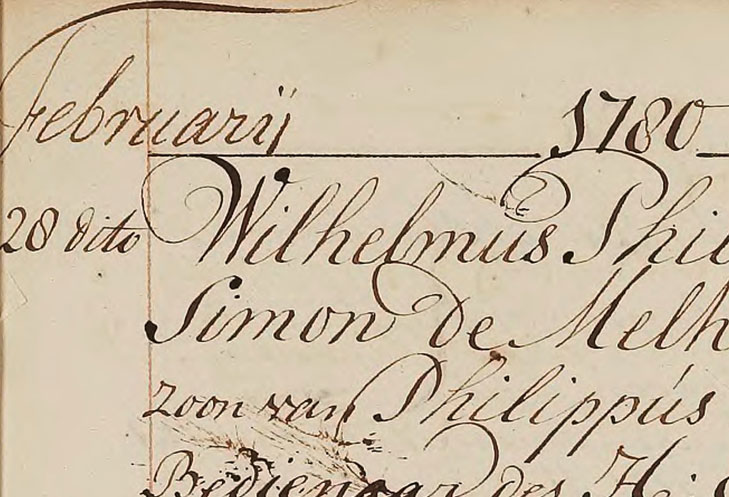Willem de Melho
A Footnote in History: the life of Willem de Melho
The interaction of Sri Lankans and the Dutch reached far beyond the island itself. Over the course of 150 years, Sri Lankan people also travelled to the Dutch Republic. We don’t know how many exactly, but we do know that around twenty of them were students of theology. They were all trained at the Dutch seminaryThe Dutch wanted each school to have a well-educated schoolmaster, and therefore started Seminaries – advanced schools – near Jaffna and in Colombo. They were mainly aimed at sons of the Lankan elites, in order to train them in Dutch government, religion and culture. Graduates could also go on to become e.g. Protestant ministers by studying in the Netherlands, or clerks in service of the VOC. More in Colombo. They studied theology to become a church minister back in Sri Lanka or elsewhere in the Dutch empire. This story is about one of them: Willem de Melho. Willem left Sri Lanka at the age of eleven to receive higher education in Amsterdam. His life serves like a kaleidoscope on a wide range of historic topics: from cultural brokerage and translation to Chettiar community conflicts and from Christian religion to Dutch revolution! His fate was sad and tragic though: Willem never returned to Sri Lanka, but instead was buried in Amsterdam.
A Footnote in History: the life of Willem de Melho
by Bente de Leede
Prestigious jobs
Willem was born in Sri Lanka in 1761 as Wilhelmus Philippus Simon de Melho, in a Tamil-speaking Chettiar family. He was reportedly a keen and amiable boy. Willem’s grandfather Simon was, together with Ondaatje family, part of a clan of which many members worked for the Dutch East India Company (VOC) and the Dutch Reformed ChurchWhen the Dutch came to Sri Lanka, they brought their church with them. This Protestant institution was known as the ‘Dutch Reformed Church’. It built churches in cities and villages all over the island, these also functioned as protestant schools, led by often local schoolmasters. In these schools children were taught reading and writing in their vernacular, on the basis of Reformed texts. More in Sri Lanka. Within the Chettiar community they formed a faction that clashed with other members of their community, one of the reasons being Simon’s presumably low status as an illegitimate child of a formerly enslaved woman. Within the colonial government, Simon climbed the social ladder quickly though, seizing the opportunity of making himself indispensable to the Dutch as the chief Tamil translator for the VOC.
Simon’s son, Philip de Melho, Willem’s father, was soon a rising star within the Dutch Reformed ChurchWhen the Dutch came to Sri Lanka, they brought their church with them. This Protestant institution was known as the ‘Dutch Reformed Church’. It built churches in cities and villages all over the island, these also functioned as protestant schools, led by often local schoolmasters. In these schools children were taught reading and writing in their vernacular, on the basis of Reformed texts. More. Philip married Magdalena Ondaatje and they had several children, among whom two sons. The Dutch considered Philip to be extremely talented and devoted. He attended the seminaryThe Dutch wanted each school to have a well-educated schoolmaster, and therefore started Seminaries – advanced schools – near Jaffna and in Colombo. They were mainly aimed at sons of the Lankan elites, in order to train them in Dutch government, religion and culture. Graduates could also go on to become e.g. Protestant ministers by studying in the Netherlands, or clerks in service of the VOC. More, became a junior minister, and wrote and translated several books in Tamil to explain and defend the Dutch protestantWestern Christianity is divided into two main denominations, Catholicism and Protestantism. The latter was dominant in the Netherlands. In Sri Lanka it was specifically the Dutch Reformed Church, a protestant form of Christianity that functioned as the official church of the VOC. More faith to his congregation in Jaffa. He was also a remarkable figure in intellectual circles in Jaffna. And while it was mandatory for all ministers within the Dutch church system to have studied theology at a university, and thus to travel to Europe, Philip de Melho refused.
It was exceptional, especially since the Dutch governor-general had specifically arranged for him to go to the Netherlands. Was Philip scared to travel to Europe for such a long time? Was he confident enough in his own ability as a minister? Whatever his reasons were, he became an exception in Dutch church history, and especially in colonial Sri Lanka, since he was ordained as a senior minister – a predikant – without a university degree. Later in his life, Philip was part of several controversies: conflicts with local headmen and a court case for fraud and adultery in Dutch court.

Living in Amsterdam
But that was before Willem went to Amsterdam. Knowing that Philip de Melho had refused to go, it is at least remarkable that he sent his youngest son Willem to attend the Atheneum in Amsterdam, and after this preparatory school to continue his theology studies at university. Fortunately, Willem was not alone: he travelled with his cousin Pieter Ondaatje, who was three years older and whose mother Hermina Quint was from Amsterdam. In 1773, the boys travelled to Galle first, where they boarded a ship to Amsterdam. In Galle, Pieter and Willem stayed with their aunt, whose late husband Petrus de Silva had been predikant as well. He did study theology in the Netherlands.
On November 16th, together with several hundreds of sailors, soldiers and merchants, the boys travelled the Indian Ocean, rounded the Cape, and arrived in Amsterdam about seven months later, on 10 June 1774. In Amsterdam they were awaited by an unfamiliar face, but a familiar name. Pieter Quint, Pieter Ondaatje’s maternal grandfather, would be their legal guardian during their stay in the Netherlands, and the boys were to live at his and their aunt Cornelia’s house. Pieter Quint was a church elder and merchant, living in the Binnen Bantammerstraat in Amsterdam, close to the docks. This street still exists, its name refers to a region in West-Java, and this has over the centuries been a neighbourhood where many Asian travellers in Amsterdam have settled.
Of Pieter and Willem’s time in Amsterdam and attending the Atheneum Illustre not much is known. Pieter decided after four years to continue his studies in Utrecht, starting with theology, and later switching to law, resulting in doctorate degrees from both the Universities of Leiden and Utrecht. He became part of the official historical canon of the Netherlands, as one of the key ideologists and charismatic leaders of the Batavian Revolution in the Netherlands.

Tragedy strikes
While this story might feel like it is just getting up to steam, this is actually where it ends. Unlike his cousin, Willem never got a degree. One of the only archival remains of Willem where he is not in the slipstream of his famous cousin or father is his record in the Burial Registry in the Amsterdam Municipal archives. In the morning of 23 February 1780, Willem had started throwing up blood and gotten chest pains. And so, at age nineteen, not quite graduated from school and after being away from his family for seven years, Willem de Melho passed away from (presumably) tuberculosis.
On February 28th, Willem was buried in the Oudezijdskapel, or St. Olof’s Chapel, at the Zeedijk in Amstederdam, close to the harbour and close to the ships returning to Sri Lanka. To add to the tragedy, the messages sent to Colombo to inform Willem’s family, friends and mentors of his death, might initially have never reached them. Several formal funeral invitations, Pieter Quint’s letter announcing and explaining Willem’s death, and an emotional letter from Aunt Cornelia about ‘her dear little Melho’ are found in the ‘Prize Papers’. These are documents seized by British navy and private ships from enemy ships between 1652-1815, that are now kept in the British national archives in London. The mail per ship already took several months, but now the tidings about Willem’s death had been delayed severely. How did the De Melho family eventually hear about the death of their beloved son and brother? Would they have expected any tragic news or were they surprised by it?
It is striking, and significant for the history of Dutch colonialism and the connection with Sri Lanka, that the administrative and physical remains of these Sri Lankan men, Willem, Philip and Simon, can still be found in Dutch records and churches in Europe.In the margins of his family members’ histories Willem might seem only a footnote, but in all these stories his memory does live on. On the picture below is Willem’s burial record. He is referred to as Wilhelmus Philippus Simon de Melho, the only son of Philippus de Melho, servant of the Holy Gospel in Jaffanapatnam [Jaffna], on the island Ceylon.

To read more from the world of the Ondaatje and De Melho families in Sri Lanka during the Dutch period, see Herman Tieken’s Between Colombo and the Cape. Letters in Tamil, Dutch and Sinhala, Sent to Nicolaas Ondaatje from Ceylon, Exile at the Cape of Good Hope (1728-1737). (Delhi: Manohar 2015.)
This story is an updated and revised version of ‘A Footnote in History: the life of Willem de Melho’, 17 December 2020 at https://stichtingnederlandsrilanka.nl/?p=605
